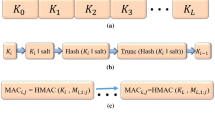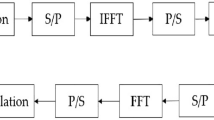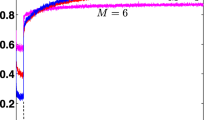Abstract
With the development of communication technology, the precious frequency spectrum is becoming more and more crowded. Exploiting the particular filter with zero group delay, ultra narrow band (UNB) modulation is intended for acquiring the high frequency efficiency. Unfortunately, this UNB filter is confronted with great challenges from the classical communication theories. The validation on its realization is also difficult. This paper proposes a novel UNB modulation, namely random pulse position keying (RPPK). It is demonstrated from analysis that there is no inessential discrete spectral line in modulated signal’s power density spectrum (PDS), and the UNB filter has been successfully avoided. Consequently, RPPK is rather explicit in theory and simple in implementation. As is shown by the simulation, the frequency utilization of RPPK can even reach 100 bits/s/Hz. Its optimum receiving performance is slightly inferior to BPSK, yet is much superior to that of other UNB modulations such as VMSK/2. Moreover, multi-access and confidentiality are additional benefits to UNB users.
Similar content being viewed by others
References
Walker H R. VPSK and VMSK modulation transmit digital audio and video at 15 bits/s/Hz. IEEE Trans Broadcast, 1997, 43: 96–103
White Paper. “Impossible” technology passes the test. http://www.vmsk.org.
Xu Y Y, Ruan M, Song W T, et al. Biphase coded modulation for wireless digital transmission (in Chinese). J Shanghai Jiaotong Univ, 2000, 34: 250–253
Hu J L, Xu S, Chen J. VMSK/2 modulation for wireless data transmission at 20 bits/s/Hz (in Chinese). J Electr, 2002, 30: 1153–1155
Li X P, Wu L N. On optimization of VWDK modulation waveforms (in Chinese). J Electr Inf Tech, 2005, 27: 1714–1716
Li X P, Wu L N. Power spectral analysis for a standard sine-like VMSK modulation (in Chinese). Chinese J Radio Sci, 2003, 18: 722–726
Li X P. On VWDK modulation technology (in Chinese). Ph.D. dissertation. Nanjing: Southeast University, 2006
Wu L N. Progress in ultra narrow band high speed communication (in Chinese). Progress Nat Sci, 2007, 17: 1467–1473
Zhao C S, Wang S B, Yang C, et al. A sine-like wave modulation technique of xMax (in Chinese). J Beijing Univ Post Telecommun, 2007, 30: 111–115
Chen X Y, Yao Q D, Liu X C. The VMSK modulation delusion (in Chinese). J Electr Inf Tech, 2003, 25: 1558–1563
Si H W, Li X P. Optimization of VWDK PDS and its performance. In: Proc of CCCT’2004, Austin, Texas, USA, 2004. 142–144
Walker H R. Digital modulation device in a system and method of using the same. US Patent. 6445737, 2002
Walker H R. Ultra Narrow Band Modulation Textbook. http://www.vmsk.org/Textbook.pdf
Proakis J G. Digital Communications. 4th ed. New York: McGrawHill, 2001
Simon M K, Hinedi S M, Lindsey W C. Digital Communication Techniques: Signal Design and Detection. Upper Saddle River, NJ: Prentice-Hall, 1995
Win M Z. Power spectral density of binary digital pulse streams in the presence of independent uniform timing jitter. In: Proc. Military Communications Conf., vol. 2, Monterey, CA, Nov. 1997. 550–553
Simon M K. Bandwidth-Efficient Digital Modulation with Application to Deep-Space Communications. New York: Wiley & Sons Inc., 2003
Sklar B. Digital Communication: Fundamentals and Applications. 2nd ed. Upper Saddle River, NJ: Prentice Hall, 2001
Win M Z, Seholtz R A. Ultra-wide bandwidth time-hopping spread-spectrum impulse radio for wireless multiple access communications. IEEE Trans Commun, 2000, 48: 679–691
Bit Error Rate of xMax vs other typical modulation systemshttp: //www.xgtechnology.com/BER-plot.asp. [2008.5.20].
Wu L N. Ultra narrow band and anti-jamming envision (in Chinese). Modern Military Commun, 2004, 12: 9
Author information
Authors and Affiliations
Corresponding author
Rights and permissions
About this article
Cite this article
Li, B., Zhou, Z. & Zou, W. RPPK modulation with high data rates. Sci. China Inf. Sci. 53, 344–354 (2010). https://doi.org/10.1007/s11432-010-0012-1
Received:
Accepted:
Published:
Issue Date:
DOI: https://doi.org/10.1007/s11432-010-0012-1




